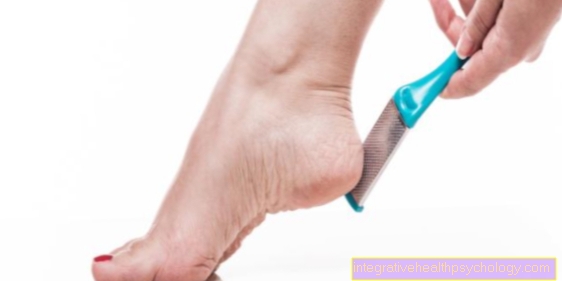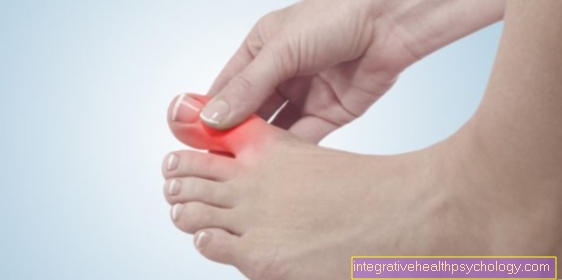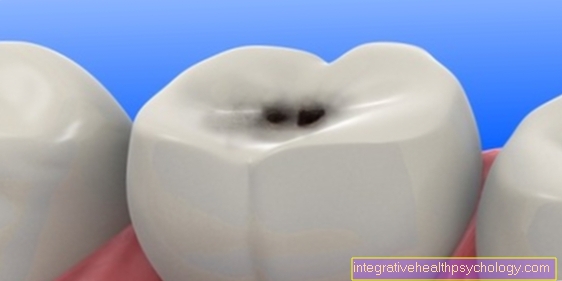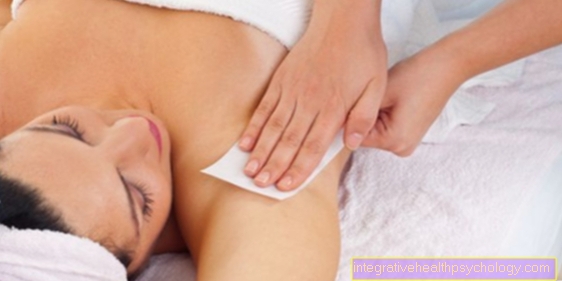Overactive sebum - symptoms and treatment
introduction
Sebum glands are very important to human skin. The fat that is secreted by the sebum glands has an important function: the skin should be kept supple and must not dry out. In some cases, however, there is an overproduction of sebum, which can, for example, lead to blockages of the sebum glands.In technical jargon, this hyperfunction of the sebum glands is called seborrhea. The overactive sebum gland can have various causes and is in itself only a symptom and not an independent disease.

Causes of an overactive sebum
The occurrence of increased sebum flow is particularly common during puberty and adolescence. Here it is assumed that a hormonal change affects the productivity of the sebum glands. As a rule, the symptom of seborrhea occurs for the first time with the onset of puberty and disappears again in the course of young adulthood. During pregnancy there are also hormonal changes, which is why an increased flow of sebum can sometimes be observed during pregnancy. Above all, the androgens (steroid hormones), i.e. the male sex hormones, are responsible for the increased activity of the sebum glands.
In addition to the hormonal causes, exogenous (external) causes can also be responsible for seborrhea. Skin care products that have a strong greasy effect or anabolic steroids are held responsible for the development of the overactive sebum. Unhealthy diet and stress are also said to have negative effects on sebum production. In addition, the increased sebum production can be an accompanying symptom of certain diseases, such as Parkinson's disease. However, with the treatment of the disease, the seborrhea also decreases.
Concomitant symptoms
In the case of an overactive sebum, the thick film of fat on the skin, fungi and bacteria provide a good breeding ground. This can then favor other skin diseases. The increased flow of sebum leads to blockages in the ducts of the sebum glands. This causes the secretion to accumulate inside the gland. If bacteria then get into the clogged sebum gland, inflammation can occur.
In acne vulgaris, it is precisely this process that causes the disease. The inflammation of blocked sebum glands creates pustules (colloquially, pimples) and papules. If there is no blockage or inflammation of the sebum glands, usually only an oily, shiny skin can be perceived as an accompanying symptom. In addition, there may be a colonization of fungi. These are often Malassezia yeast mushrooms. The oily skin provides a good breeding ground for the mushrooms. The Malassezia mushrooms metabolize the sebum and release the metabolic products onto the skin. These metabolic products can lead to skin rashes known as seborrheic eczema. Seborrheic eczema is often associated with flaking and redness.
Influence on the hair and scalp
The sebum glands are also essential on the scalp. The hair remains supple and does not become brittle thanks to the fat secreted by the sebum glands. The shiny appearance is also related to the sebum. However, if there is excessive sebum production on the scalp, the hair becomes greasy particularly quickly. In addition to the aesthetic problem, overactive sebum glands also lead to the development of psoriasis. There are special shampoos for oily hair that wash the oil from the scalp more effectively. In addition, lipid-replenishing products should be avoided.
Influence on the face
The overactive sebum leads to the greatest problems in the face in particular, as unaesthetic features are particularly noticeable on the face. The so-called T-zone, which is made up of the forehead, nose and chin, is most frequently affected by the overactive sebum. Especially in connection with inflammation or even the development of acne vulgaris, this can be very stressful for those affected. A gentle cleaning, which should be done a maximum of two times a day, helps. In addition, greasy creams should not be used on the face.
Also read our topic: Sebum hyperplasia
Diagnosis of overactive sebum
The diagnosis of overactive sebum is usually a visual diagnosis. This means that the diagnosis can be made by simply looking at the affected areas. The so-called T-zone in particular is often affected. The T-zone is an area on the face which, in the form of the letter T, covers the forehead, nose and chin. When seborrhea is present, the skin is shiny due to the oil. In addition, blackheads and pimples can often be seen in the affected areas of the skin.
Treatment of overactive sebum
Unfortunately, the treatment of sebum glands is limited. It is difficult to influence the function of the sebum glands, so treatment is mainly limited to removing the excess sebum.
One way to eliminate the hormonal causes of the sebum overactive is to take hormones. Here, estrogens (female sex hormones) are taken, which counteract the high androgen level. However, the intake of female sex hormones can only be carried out by women; severe side effects would be to be feared in men.
In addition to hormonal manipulation, seborrhea should be treated mainly with mild cleansing. The skin should be washed with a mild soap a maximum of two times a day. If you wash yourself more often, the protective acid layer of the skin is attacked. You can then use a facial toner with alcohol, which causes the pores of the skin to contract. In addition, the skin should be cared for with non-greasy skin care products. For example, hydrogels are suitable for this. In most cases, however, one has to be patient and wait for the hormonal causes to become redundant over time. This is usually the case during the third decade of life.
Duration
The duration of the overactive sebum always depends very much on the cause. The most common reason is a change in the hormonal balance. In adolescents, symptoms can therefore last between a few years and around two decades. In pregnant women, sebum production should return to normal after pregnancy. In connection with other illnesses such as Parkinson's, the symptoms can persist alongside the illness. However, if the underlying disease is treated with medication, the overactive sebum is usually reduced.




























